Abstract
Shorea balangeran is an important component of peat swamp forests in Southeast Asia and is an important source of timber. However, S. balangeran has been decreasing in number due to overexploitation. The objective of this study was to investigate the effect of inoculation of native ectomycorrhizal (ECM) fungi on growth of S. balangeran in degraded peat swamp forest. Spores of Boletus sp., Scleroderma sp., and Strobilomyces sp. were collected from natural peat swamp forest in Indonesia. Seedlings of S. balangeran were inoculated with or without (control) spores and grown in sterilized peat soil under nursery conditions for 6 months. Then, the seedlings were transplanted into a degraded peat swamp forest and grown for 40 months. ECM colonization was 59–67% under nursery conditions and increased shoot height and weight. Shoot height, stem diameter, and survival rates were higher in inoculated seedlings than in control 40 months after transplantation. The results suggest that inoculation of native ECM fungi onto native tree species is useful for reforestation of degraded peat swamp forests.


Similar content being viewed by others
References
Alexander I, Lee SS (2005) Mycorrhizas and ecosystems processes in tropical rain forest: implications for diversity. In: Burslem DFRP, Pinard MA, Hartley SE (eds) Biotic interactions in the tropics: their role in the maintenance of species diversity. Cambridge University Press, New York, pp 165–203
Alexander I, Ahmad N, See LS (1992) The role of mycorrhizas in the regeneration of some Malaysian forest trees. Philos Trans R Soc Lond B 335:379–388
Appanah S, Turnbull JM (1998) A review of dipterocarps: taxonomy, ecology and silviculture. Center for International Forestry Research, Bogor
Brundrett M, Bougher N, Dell B, Grove T, Malajczuk N (1996) Working with mycorrhizas in forestry and agriculture. Australian Centre for International Agricultural Research, Canberra
Brundrett M, Malajczuk N, Gong MQ, Xu DP, Snelling S, Dell B (2005) Nursery inoculation of eucalyptus seedlings in Western Australia and Southern China using spores and mycelial inoculum of diverse ectomycorrhizal fungi from different climatic regions. For Ecol Manag 209:193–205
Chen YL, Kang LH, Dell B (2006) Inoculation of Eucalyptus urophylla with spores of Scleroderma in a nursery in south China: comparison of field soil and potting mix. For Ecol Manag 222:439–449
Di Battista C, Bouchard D, Martin F, Genere B, Amirault JM, Le Tacon F (2002) Survival after outplanting of the ectomycorrhizal fungus Laccaria bicolor S238N inoculated on Douglas fir (Pseudotsuga menziesii (Mirb.) Franco) cuttings. Ann For Sci 59:81–92
Ducousso M, Galiana A, Chaix G, Prin Y (2004) Relative infectivity of two Pisolithus spp. strains inoculated to the nitrogen-fixing legume tree Acacia crassicarpa A. Cunn. ex Benth. in a field experiment in Madagascar. Eur J Soil Biol 40:105–111
Duponnois R, Founoune H, Masse D, Pontanier R (2005) Inoculation of Acacia holosericea with ectomycorrhizal fungi in a semiarid site in Senegal: growth response and influences on the mycorrhizal soil infectivity after 2 years plantation. For Ecol Manag 207:351–362
Garbaye J, Delwaulle JC, Diangana D (1988) Growth-response of eucalypts in the Congo to ectomycorrhizal inoculation. For Ecol Manag 24:151–157
Gardner JH, Malajczuk N (1988) Recolonization of rehabilitated bauxite mine sites in Western-Australia by mycorrhizal fungi. For Ecol Manag 24:27–42
Högberg P (1982) Mycorrhizal associations in some woodland and forest trees and shrubs in Tanzania. New Phytol 92:407–415
Jeffries P (1999) Scleroderma. In: CJW G, Chambers SM (eds) Ectomycorrhizal fungi key genera in profile. Springer, Berlin, pp 187–200
Lee SS (1998) Root symbiosis and nutrition. In: Appanah S, Turnbull JM (eds) A review of dipterocarps: taxonomy, ecology and silviculture. Center for International Forestry Research, Bogor, pp 99–114
Lee SS, Alexander IJ (1996) The dynamics of ectomycorrhizal fungi of Shorea leprosula seedlings in Malaysian rain forests. New Phytol 132:297–305
Lee SS, Lim KL (1989) Mycorrhizal infection and foliar phosphorus-content of seedlings of 3 dipterocarp species growing in a selectively logged forest and a forest plantation. Plant Soil 117:237–241
Lu XH, Malajczuk N, Dell B (1998) Mycorrhiza formation and growth of Eucalyptus globulus seedlings inoculated with spores of various ectomycorrhizal fungi. Mycorrhiza 8:81–86
Lu XH, Malajczuk N, Brundrett M, Dell B (1999) Fruiting of putative ectomycorrhizal fungi under blue gum (Eucalyptus globulus) plantations of different ages in Western Australia. Mycorrhiza 8:255–261
Marx DH, Hedin A, Toe SFP (1985) Field performance of Pinus-caribaea var hondurensis seedlings with specific ectomycorrhizae and fertilizer after three years on a savanna site in Liberia. For Ecol Manag 13:1–25
Page SE, Rieley JO, Shotyk OW, Weiss D (1999) Interdependence of peat and vegetation in a tropical peat swamp forest. Philos Trans R Soc Lond B Biol Sci 354:1885–1897
Parlade J, Luque J, Pera J, Rincon AM (2004) Field performance of Pinus pinea and P. halepensis seedlings inoculated with Rhizopogon spp. and outplanted in formerly arable land. Ann For Sci 61:507–514
Pera J, Alvarez IF, Rincon A, Parlade J (1999) Field performance in northern Spain of Douglas-fir seedlings inoculated with ectomycorrhizal fungi. Mycorrhiza 9:77–84
Selosse MA, Bouchard D, Martin F, Le Tacon F (2000) Effect of Laccaria bicolor strains inoculated on Douglas-fir (Pseudotsuga menziesii) several years after nursery inoculation. Can J For Res (Revue Canadienne De Recherche Forestiere) 30:360–371
Sims K, Watling R, DelaCruz R, Jeffries P (1997) Ectomycorrhizal fungi of the Philippines: a preliminary survey and notes on the geographic biodiversity of the Sclerodermatales. Biodivers Conserv 6:45–58
Sirikantaramas S, Sugioka N, Lee SS, Mohamed L, Lee HS, Szmidt AE, Yamazaki T (2003) Molecular identification of ectomycorrhizal fungi associated with Dipterocarpaceae. Tropics 13:69–77
Smits WTM (1994) Dipterocarpaceae: mycorrhizae and regeneration. Backhuys Publishers, Leiden
Soerianegara I, Lemmens RHMJ (1994) Timber trees: major commercial timbers. Plant Resources of South-East Asia No. 5, Bogor
Takakai F, Morishita T, Hashidoko Y, Darung U, Kuramochi K, Dohong S, Limin SH, Hatano R (2006) Effects of agricultural land-use change and forest fire on N2O emission from tropical peatlands, Central Kalimantan, Indonesia. Soil Sci Plant Nutr 52:662–674
Tata HL, van Noordwijk M, Summerbell R, Werger MJA (2010) Limited response to nursery-stage mycorrhiza inoculation of Shorea seedlings planted in rubber agroforest in Jambi, Indonesia. New For 39:51–74
Tawaraya K, Takaya Y, Turjaman M, Tuah SJ, Limin SH, Tamai Y, Cha JY, Wagatsuma T, Osaki M (2003) Arbuscular mycorrhizal colonization of tree species grown in peat swamp forests of Central Kalimantan, Indonesia. For Ecol Manag 182:381–386
Turjaman M, Tamai Y, Segah H, Limin SH, Cha JY, Osaki M, Tawaraya K (2005) Inoculation with the ectomycorrhizal fungi Pisolithus arhizus and Scleroderma sp. improves early growth of Shorea pinanga nursery seedlings. New For 30:67–73
Turjaman M, Tamai Y, Segah H, Limin SH, Osaki M, Tawaraya K (2006) Increase in early growth and nutrient uptake of Shorea seminis seedlings inoculated with two ectomycorrhizal fungi. J Trop For Sci 18:243–249
Turner IM, Brown ND, Newton AC (1993) The effect of fertilizer application on dipterocarp seedling growth and mycorrhizal infection. For Ecol Manag 57:329–337
Yazid SM, Lee SS, Lapeyrie F (1994) Growth-stimulation of Hopea spp. (Dipterocarpaceae) seedlings following ectomycorrhizal inoculation with an exotic strain of Pisolithus tinctorius. For Ecol Manag 67:339–343
Acknowledgments
This research was supported in part by the RONPAKU program, the Core University Program of Japan Society for the Promotion of Science (JSPS), a Grant-in-Aid for Scientific Research from the Ministry of Education, Sports, Science and Technology, Japan (No. 192555016), and the Sumitomo Foundation.
Author information
Authors and Affiliations
Corresponding author
Rights and permissions
About this article
Cite this article
Turjaman, M., Santoso, E., Susanto, A. et al. Ectomycorrhizal fungi promote growth of Shorea balangeran in degraded peat swamp forests. Wetlands Ecol Manage 19, 331–339 (2011). https://doi.org/10.1007/s11273-011-9219-1
Received:
Accepted:
Published:
Issue Date:
DOI: https://doi.org/10.1007/s11273-011-9219-1




